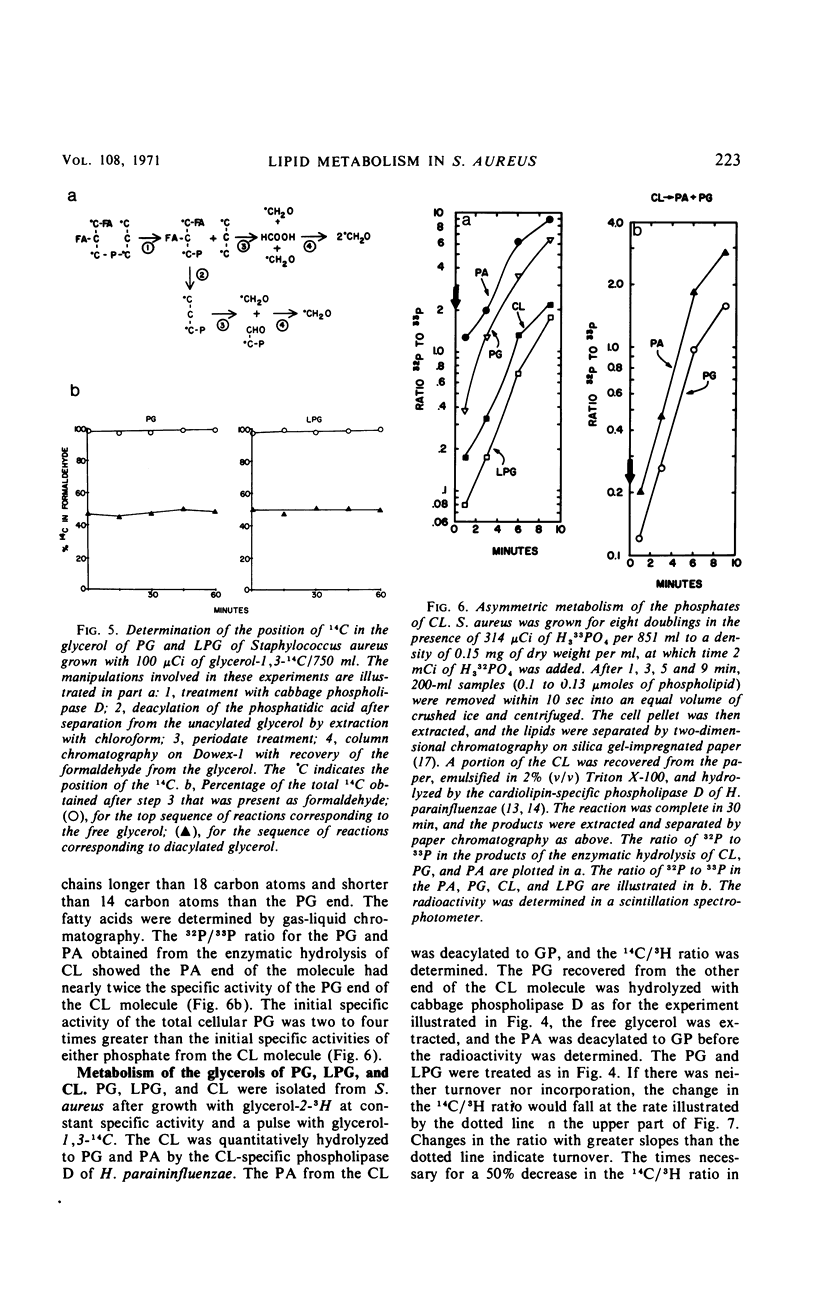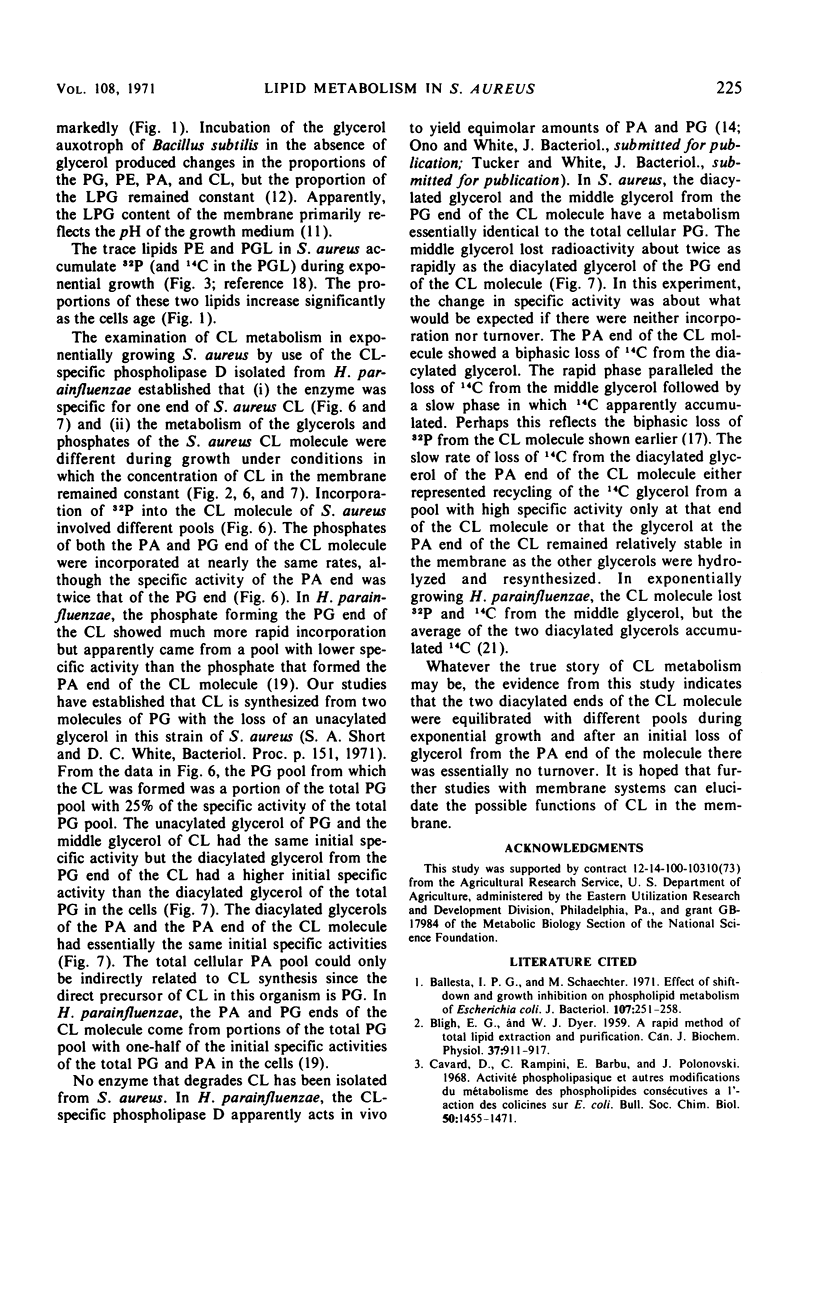Abstract
Staphylococcus aureus accumulated cardiolipin (CL) and lost phosphatidylglycerol (PG) during the stationary phase of growth. The minor lipids, phosphatidylethanolamine and phosphatidylglucose, also accumulated, whereas the lysylphosphatidylglycerol (LPG) content of the membrane remained constant as stationary phase continued. During exponential growth, the proportions and total content of phospholipids per cell remained constant. The metabolism of the phospholipids was examined under these conditions. In pulse-chase experiments, the phospholipids lost 14C from the glycerols slower than 32P. When the phospholipids were labeled with 14C glycerol, the unacylated glycerols of PG and LPG lost 14C, whereas the diacylated glycerols either accumulated or did not lose 14C. In all experiments, the PG showed a more rapid metabolism than the LPG. When staphylococcal CL was hydrolyzed by Haemophilus parainfluenzae CL-specific phospholipase D into phosphatidic acid (PA) and PG, the incorporation of 32P into both of the phosphates of CL was found to be parallel at both the PG and PA ends of the molecule. However, the specific activity of the 32P at the PA end was twice that at the PG end of the molecule. The PG end of the CL apparently came from a portion of the cellular PG pool with about 20% the specific activity of the total cellular PG. The turnover of two of the glycerols of the PG portion of CL was like that of the cellular PG. The diacylated glycerol of the PG and of CL and of the membrane PG showed neither turnover nor incorporation of 14C. Half of the radioactivity was lost from the middle glycerol of CL and the free glycerol of the cellular PG in one bacterial doubling. The diacylated glycerol from the other end of the CL molecule (the PA end) lost radioactivity almost as rapidly as the middle glycerol for 10 min. After the initial rapid loss, the turnover slowed to a rate 10 times slower than the middle glycerol, indicating that the 14C was actually accumulating at this end of the molecule. The phosphates and glycerols involved in the hydrolysis and resynthesis of the CL molecule during exponential growth in S. aureus apparently come from different pools of PG.
Full text
PDF







Selected References
These references are in PubMed. This may not be the complete list of references from this article.
- BLIGH E. G., DYER W. J. A rapid method of total lipid extraction and purification. Can J Biochem Physiol. 1959 Aug;37(8):911–917. doi: 10.1139/o59-099. [DOI] [PubMed] [Google Scholar]
- Ballesta J. P., Schaechter M. Effect of shift-down and growth inhibition on phospholipid metabolism of Escherichia coli. J Bacteriol. 1971 Jul;107(1):251–258. doi: 10.1128/jb.107.1.251-258.1971. [DOI] [PMC free article] [PubMed] [Google Scholar]
- Cavard D., Rampini C., Barbu E., Polonovski J. Activité phospholipasique et autres modifications du métabolisme des phospholipides consécutives a l'action des colicines sur E. coli. Bull Soc Chim Biol (Paris) 1968 Dec;50(9):1455–1471. [PubMed] [Google Scholar]
- Cronan J. E., Jr Phospholipid alterations during growth of Escherichia coli. J Bacteriol. 1968 Jun;95(6):2054–2061. doi: 10.1128/jb.95.6.2054-2061.1968. [DOI] [PMC free article] [PubMed] [Google Scholar]
- Frerman F. E., White D. C. Membrane lipid changes during formation of a functional electron transport system in Staphylococcus aureus. J Bacteriol. 1967 Dec;94(6):1868–1874. doi: 10.1128/jb.94.6.1868-1874.1967. [DOI] [PMC free article] [PubMed] [Google Scholar]
- GALE E. F., FOLKES J. P. THE INCORPORATION OF GLYCEROL AND LYSINE INTO THE LIPID FRACTION OF STAPHYLOCOCCUS AUREUS. Biochem J. 1965 Feb;94:390–400. doi: 10.1042/bj0940390. [DOI] [PMC free article] [PubMed] [Google Scholar]
- Gould R. M., Lennarz W. J. Metabolism of Phosphatidylglycerol and Lysyl Phosphatidylglycerol in Staphylococcus aureus. J Bacteriol. 1970 Dec;104(3):1135–1144. doi: 10.1128/jb.104.3.1135-1144.1970. [DOI] [PMC free article] [PubMed] [Google Scholar]
- HOUTSMULLER U. M., VAN DEENENL ON THE ACCUMULATION OF AMINO ACID DERIVATIVES OF PHOSPHATIDYLGLYCEROL IN BACTERIA. Biochim Biophys Acta. 1964 Feb 24;84:96–98. doi: 10.1016/0926-6542(64)90106-4. [DOI] [PubMed] [Google Scholar]
- Hammond R. K., White D. C. Carotenoid formation by Staphylococcus aureus. J Bacteriol. 1970 Jul;103(1):191–198. doi: 10.1128/jb.103.1.191-198.1970. [DOI] [PMC free article] [PubMed] [Google Scholar]
- Hammond R. K., White D. C. Formation of vitamin K2 isoprenologues by Staphylococcus aureus. J Bacteriol. 1969 Nov;100(2):573–578. doi: 10.1128/jb.100.2.573-578.1969. [DOI] [PMC free article] [PubMed] [Google Scholar]
- Lillich T. T., White D. C. Phospholipid metabolism in the absence of net phospholipid synthesis in a glycerol-requiring mutant of Bacillus subtilis. J Bacteriol. 1971 Sep;107(3):790–797. doi: 10.1128/jb.107.3.790-797.1971. [DOI] [PMC free article] [PubMed] [Google Scholar]
- Ono Y., White D. C. Cardiolipin-specific phospholipase D activity in Haemophilus parainfluenzae. J Bacteriol. 1970 Jul;103(1):111–115. doi: 10.1128/jb.103.1.111-115.1970. [DOI] [PMC free article] [PubMed] [Google Scholar]
- Ono Y., White D. C. Cardiolipin-specific phospholipase D of Haemophilus parainfluenzae. II. Characteristics and possible significance. J Bacteriol. 1970 Nov;104(2):712–718. doi: 10.1128/jb.104.2.712-718.1970. [DOI] [PMC free article] [PubMed] [Google Scholar]
- Randle C. L., Albro P. W., Dittmer J. C. The phosphoglyceride composition of Gram-negative bacteria and the changes in composition during growth. Biochim Biophys Acta. 1969;187(2):214–220. doi: 10.1016/0005-2760(69)90030-7. [DOI] [PubMed] [Google Scholar]
- Short S. A., White D. C., Aleem M. I. Phospholipid metabolism in Ferrobacillus ferrooxidans. J Bacteriol. 1969 Jul;99(1):142–150. doi: 10.1128/jb.99.1.142-150.1969. [DOI] [PMC free article] [PubMed] [Google Scholar]
- Short S. A., White D. C. Metabolism of the glycosyl diglycerides and phosphatidylglucose of Staphylococcus aureus. J Bacteriol. 1970 Oct;104(1):126–132. doi: 10.1128/jb.104.1.126-132.1970. [DOI] [PMC free article] [PubMed] [Google Scholar]
- Stárka J., Moravová J. Phospholipids and cellular division of Escherichia coli. J Gen Microbiol. 1970 Feb;60(2):251–257. doi: 10.1099/00221287-60-2-251. [DOI] [PubMed] [Google Scholar]
- White D. C., Frerman F. E. Extraction, characterization, and cellular localization of the lipids of Staphylococcus aureus. J Bacteriol. 1967 Dec;94(6):1854–1867. doi: 10.1128/jb.94.6.1854-1867.1967. [DOI] [PMC free article] [PubMed] [Google Scholar]
- White D. C., Tucker A. N. Phospholipid metabolism during bacterial growth. J Lipid Res. 1969 Mar;10(2):220–233. [PubMed] [Google Scholar]


